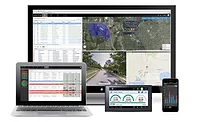Telematics helps drive the bottom line
Fleet managers utilize telematics to cut costs, boost efficiency
With fuel prices hovering near the $4 a gallon range, drivers across the industry are looking for ways to cut costs and boost vehicle efficiency. Some fleet managers have turned to telematics to help monitor fleet performance and reduce overall vehicle costs.
Jim Coker, general manager of M.L. Wismer Distributing, Baytown, Texas, said in a statement that his fleet of 64 trucks has experienced a reduction in fuel costs and idling times since using fleet management solutions from Wellesley Hills, Mass.-based Fleetmatics. “We are saving at least 4.5 gallons of gas per week, per vehicle,” he said in a statement. “With more than 60 vehicles, that adds up quickly. It’s saving us $2,835 per month on fuel.”
The detailed reports and alerts provided by Fleetmatics’ system helped M.L. Wismer find efficiency holes in its distribution chain, Coker said in a statement. For example, Fleetmatics’ Idling Alert feature helped Coker discover that one of his trucks was having starter problems so the driver would let the engine idle all day instead of turning it on and off, he said. This alert helped M.L. Wismer to act on the data, fix the problem, and reduce operating costs, he said.
According to Fleetmatics Senior Regional Account Manager Duane McIntyre, the company also offers a Fuel Card integration feature that can help businesses cut costs and monitor fuel usage across their fleets. This feature allows a manager to see when and where a driver fills up the truck’s fuel tank, check detailed transaction reports for fuel purchases, and pinpoint fuel-wasting practices or unauthorized use. By taking advantage of this, Coker said M.L. Wismer was able to reduce unauthorized use of company vehicles and further cut fleet costs. It also, in turn, helped M.L. Wismer to boost overall productivity by identifying and eliminating inefficiencies, he said in a statement. “We went from, ‘We don’t have enough vehicles,’ to [having] vehicles that have not been started in days,” he said in a statement. “Also, we went from ‘We need more people’ to ‘We have extra time?’” he added, illustrating that the company has been able to accomplish more with the same number of people due to the insight gained from telematics.
Fleets can further cut fuel costs and boost productivity by using telematics to optimize their routes, says Thom Russell, associate director of telematics marketing and business development for Verizon Communications Inc., New York. Although drivers often have predefined routes for their deliveries, telematics systems can help them adjust their routes when unforeseen route disruptions like heavy traffic or construction come into play. Verizon’s Networkfleet Connect system can connect to Olathe, Kan.-based Garmin International Inc.’s in-cab devices to show drivers live traffic information and help them navigate around jams in order to reach their destination on time, the company says.
Similarly, the RydeSmart fleet management tool by Miami-based Ryder System Inc. has integrated Google Maps-like features with a red/yellow/green route color scheme to illustrate the flow of traffic on different roads. This feature can be especially important for fleet managers as they manage their trucks out in the field, says Krish Inbarajan, senior director of telematics for Ryder. The Web-based and mobile app-based functionalities of the tool allow managers in the back office to see the locations of all of their trucks as well as traffic flow on their routes to determine potential delays, he says. In turn, they can communicate these delays to their customers and facilitate good customer service, he adds.
When route plans change, fleet managers can communicate assignment changes with their drivers through telematics solutions as well, according to Ashley Jones, director of marketing for Atlanta-based NexTraq. The company’s same-named telematics solution now offers a Job Schedule Board feature, which launched last November, that allows managers to drag and drop assignments and dispatch them to drivers, she says. With the click of a button, the manager also can view all pending jobs, work orders and appointments as well as driver and employee availability, according to the company’s website. By improving communication through this telematics solution, the fleet also can boost its efficiency as well as its service revenue, the company adds.
Smart driving
“Telematics is essentially giving customers in the beverage space more insight on where the truck is, and as a result of which, they’re able to communicate with their customers as to what the delivery status is,” Ryder’s Inbarajan explains. Based on this data, managers can gain an overall perspective of their fleets’ operations and take action to improve their metrics, he says.
However, if these metrics are not accurate, these monitoring attempts are futile, Inbarajan notes. In order to ensure that telematics solutions draw the most accurate data possible from vehicles, Ryder has specialized service technicians that manage the installation and maintenance of its products in its customers’ vehicles, he says. “You need to make sure it connects to the vehicle information in the right way,” Inbarajan explains.
Ryder also performs surveys of different vehicles based on models and production years to create specific instructions for proper installation in each type of vehicle, he says. In addition, the technicians ensure that the equipment is properly mounted so as not to be a safety hazard to the drivers and that it has sufficient connectivity to the vehicle’s antenna to transmit the metrics to the fleet’s back office, he adds.
Once plugged in, telematics solutions help fleet managers pull and monitor metrics that not only boost their efficiency but also their profitability by protecting their fleet’s cargo.
To protect the integrity of temperature-sensitive products like some juices and dairy products, NexTraq offers temperature sensors that monitor the temperature inside the cargo area of the truck. These sensors also can send alerts to NexTraq’s telematics solutions when a temperature threshold has been reached to allow the operator to make the appropriate adjustments. This, in turn, helps transportation companies reduce product loss and increase profit while improving shipment quality, NexTraq says. In the event of a claim, managers also can reference temperature records to prove compliance, it adds.
Omnitracs Inc., a subsidiary of San Diego, Calif.-based Qualcomm Inc., offers its Trailer Tracks 210 (TT201) solution to provide further visibility into cargo safety. Beyond offering insight into the location and status of a fleet’s trailers, it also shows when the cargo doors are opened and closed as well as the presence or absence of cargo, says Adam Kahn, Omnitracs’ director of fleet solutions. This can provide further product protection and even prevent theft, experts note.
Of course, delivery drivers cannot transport goods to their destinations unless their trucks are in good working order. When managing a fleet, it can sometimes be hard to remember to regularly check each vehicle and perform routine maintenance. To help remind drivers and fleet operators about these regular, necessary care steps, Networkfleet offers its Lifecycle Service Management solution to automate maintenance scheduling. The solution provides automatic maintenance reminders for activities such as oil changes or tune-ups for an unlimited number of vehicles. These reminders can be set by engine hours, mileage, calendar time or any combination of these, the company says. In addition, fleet managers can use Lifecycle Service Management to create service records that are fully integrated with Networkfleet’s GPS fleet tracking system and engine diagnostic monitoring system, which sends trouble code alerts from the vehicle, it notes. It also can display when maintenance was performed and by whom, it says. By working with this solution, fleet managers are better equipped to keep their vehicles up and running and have greater access to information about their fleet’s overall health, it adds.
Safety first
In addition to taking care of their vehicles, fleet managers are concerned with taking care of their drivers. Telematics solutions offer driver monitoring features that can help promote safe driving.
For example, Garden Grove, Calif.-based Teletrac Inc.’s Fleet Director software offers a Safety Analytics feature that allows fleet managers to proactively monitor driver behavior and promote safe driving. Safety Analytics gives each driver a comprehensive score based on unsafe driving behaviors like hard braking, stop sign violation, speeding, harsh cornering and harsh acceleration. These metrics can help drivers and managers identify areas of improvement to protect the safety of the driver.
In April, NexTraq also released its own Driver Safety Scorecard feature within its telematics solutions. In addition to monitoring individual driver behavior, the Driver Safety Scorecard also provides a graphic ranking of best and worst drivers, allowing business owners and fleet managers to identify risky drivers and take proactive actions to teach drivers to be safer behind the wheel, the company says. In taking steps to improve safe driving within the fleet, businesses can cut down on fuel costs and vehicle wear and tear, as well as insurance and potential collision expenses, it says.
Drivers also need to be well rested in order to drive safely. The Federal Motor Carrier Safety Administration, an arm of the U.S. Department of Transportation, limits when and how far an individual driver can drive in order to keep fatigued drivers off the road and promote overall safety. Telematics can help fleets track how long drivers are operating their trucks in order to better adhere to these limits.
According to Fleetmatics’ McIntyre, one of the biggest innovations in telematics recently is the use of electronic on-board recorders to automatically log a driver’s hours. This replaces the sometimes inaccurate pen-and-paper logs previously used, he explains. However, this typically requires some type of on-board computer to enable this logging. Therefore, Fleetmatics offers a Bring Your Own Device program that allows drivers to use any Android-powered device for automatic logging, he says.
Beyond the rewards of driver safety and reduced damage costs, plug-in telematics devices also can help fleets save on their insurance bills. Verizon offers its aftermarket In-Drive device, which gathers driver behavior diagnostics and vehicle diagnostics while also offering navigation assistance and connectivity to roadside assistance services. The collected diagnostics can help fleets work with their insurance companies for insurance discounts, according to Verizon’s Russell.
By providing insurance discounts, improving driver safety, and optimizing routes to save fuel and make deliveries on time, telematics solutions are enhancing fleet performance by helping them to make the best use of their assets at all times.
Looking for a reprint of this article?
From high-res PDFs to custom plaques, order your copy today!






